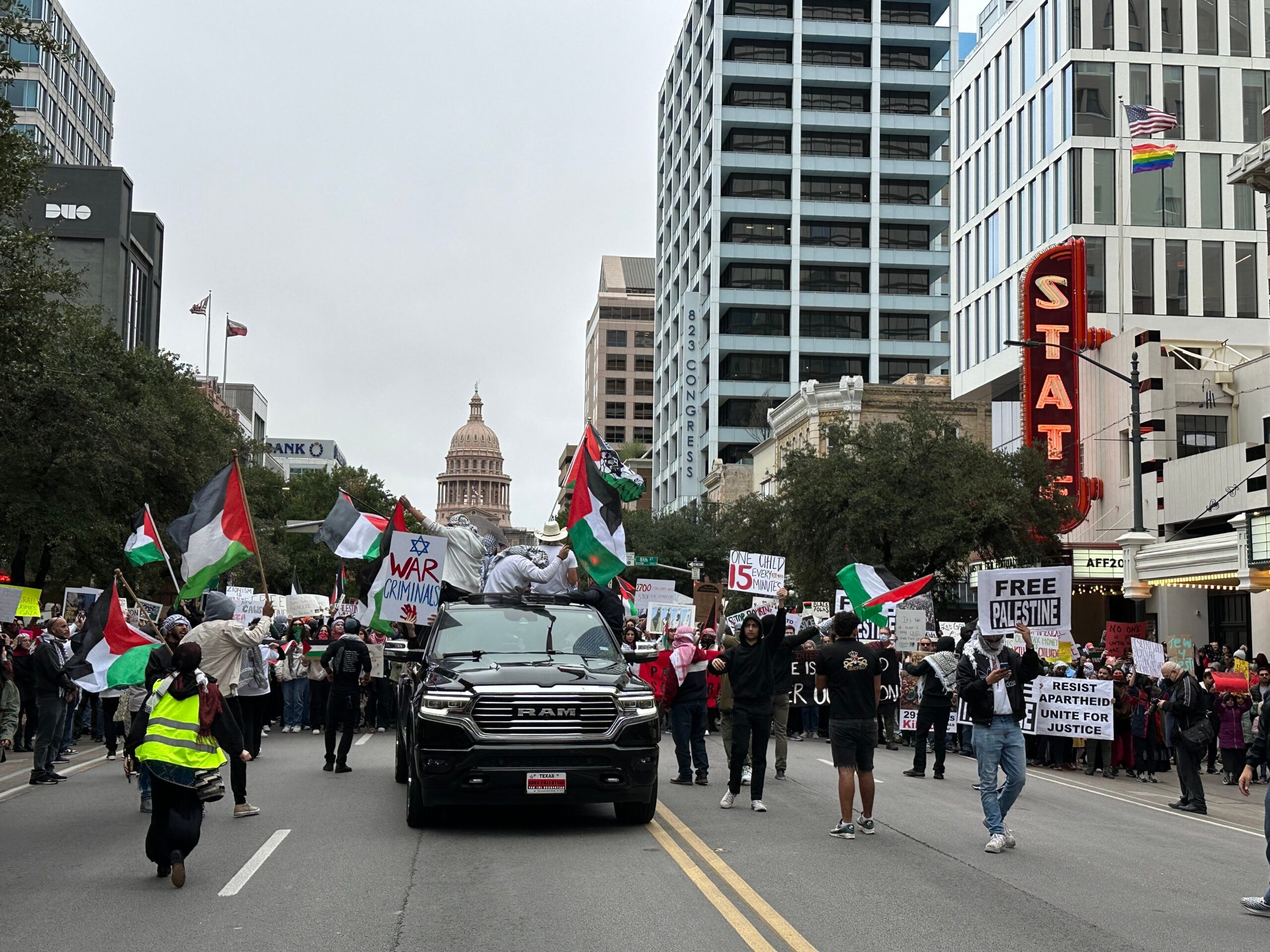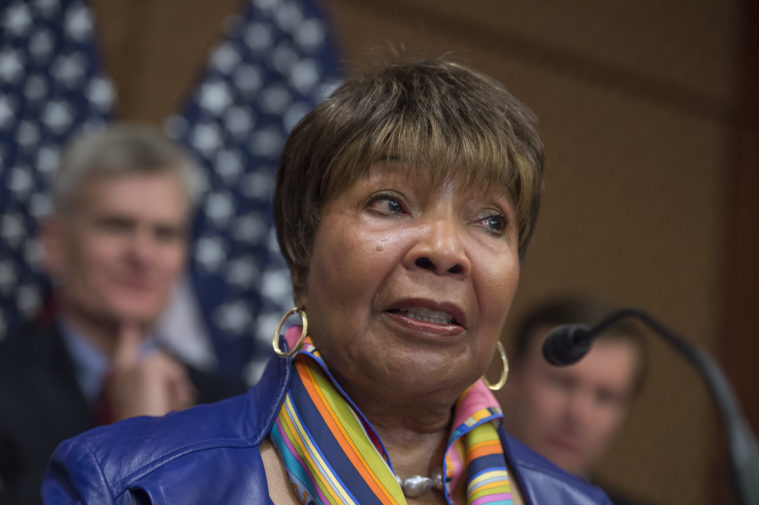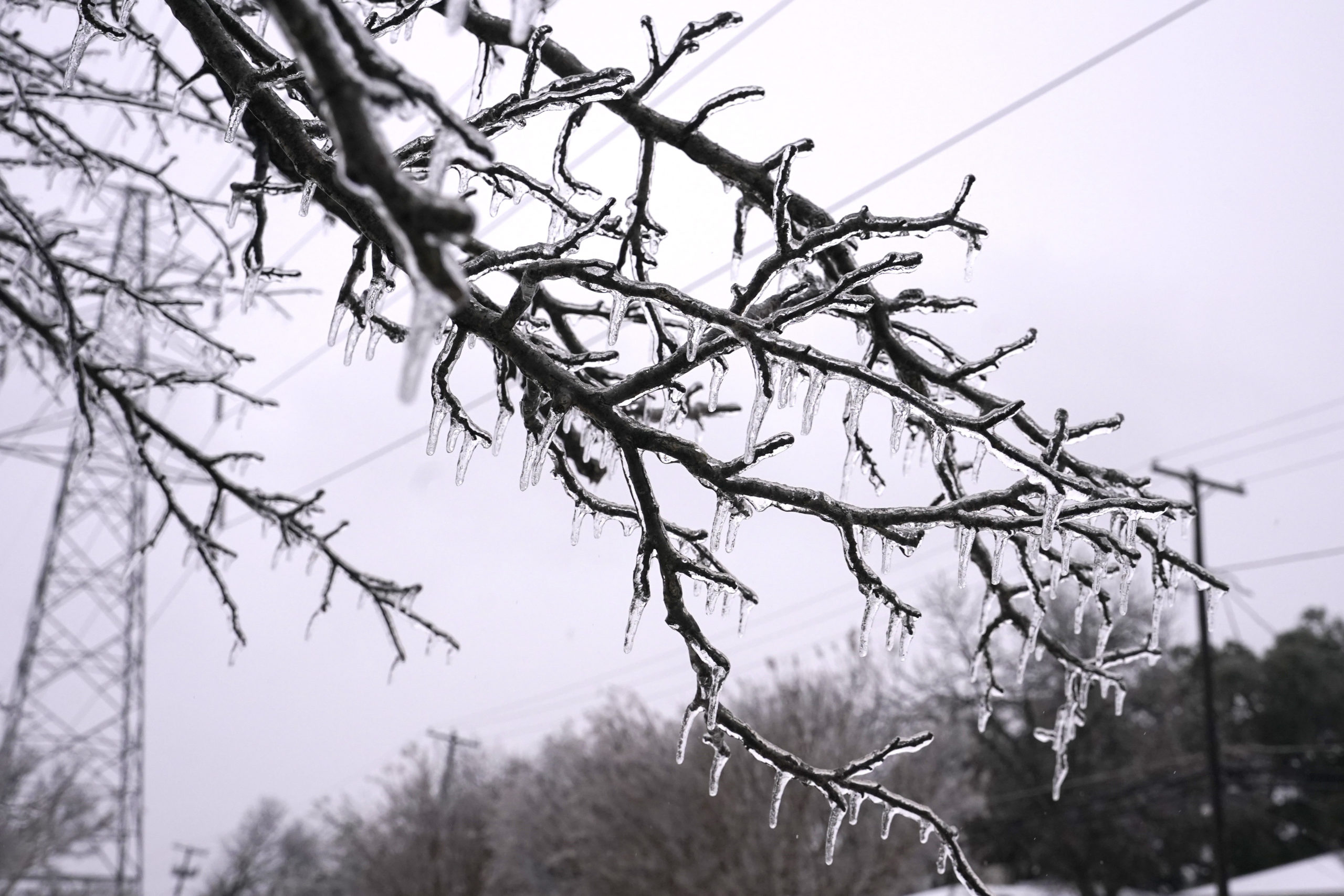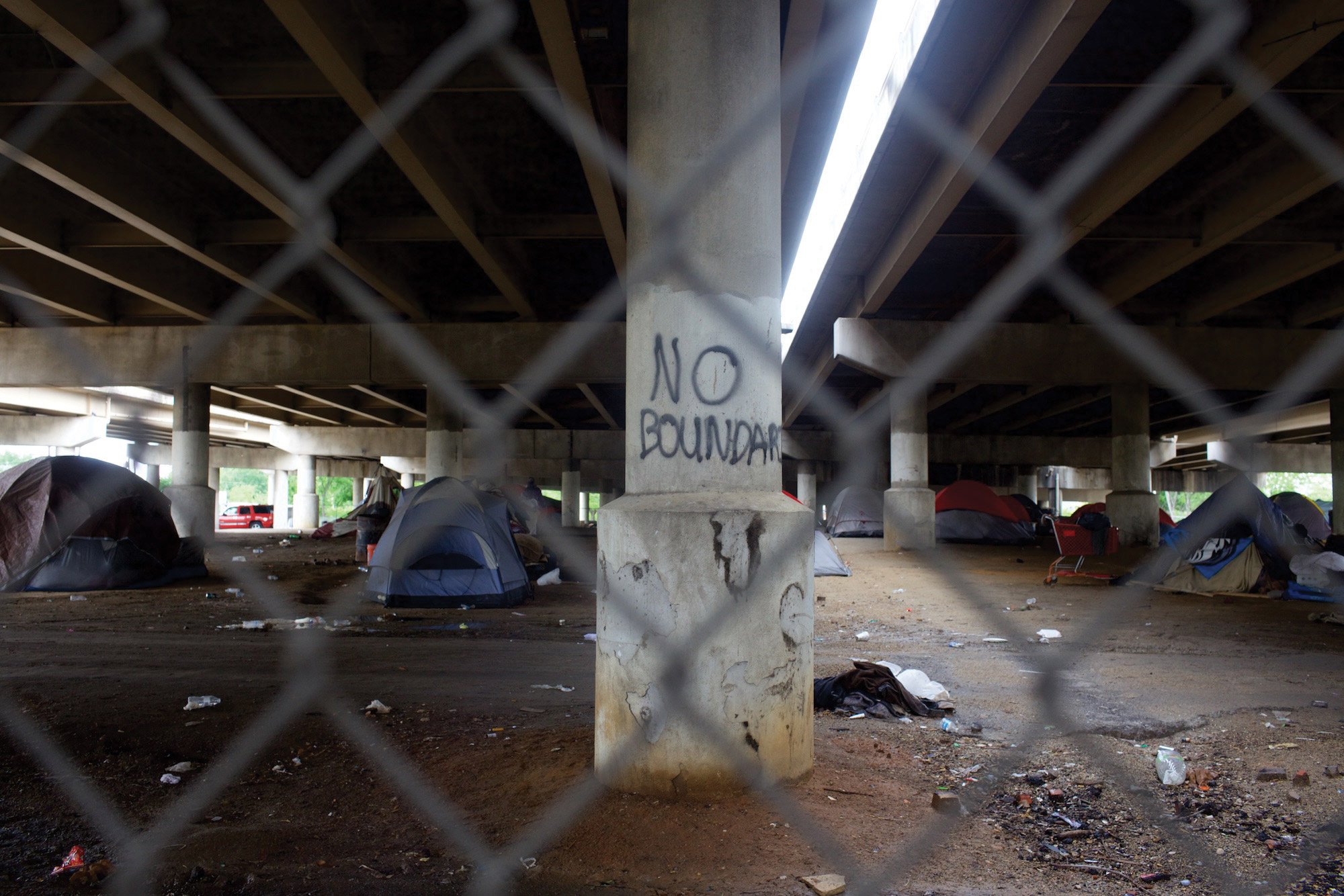
The Last Days of Tent City
As authorities prepared to evict its residents, a reporter spent six weeks in Dallas’ biggest homeless camp.
A version of this story ran in the August 2016 issue.
The Last Days of Tent City
As authorities prepared to evict its residents, a reporter spent six weeks in Dallas’ biggest homeless camp.
The murders were the catalyst. Now the authorities had to do something. On February 17, a Dallas Morning News headline declared that “Dallas officials want Tent City shut down after 2nd killing in a month.” In early March, the City Council approved a plan to empty the homeless encampment, a five-block stretch beneath I-45 at the point where it meets I-30, about a mile south of downtown.
“This is no way for any human to live,” Mayor Mike Rawlings declared. “I don’t care if someone says, ‘I want to live underneath this bridge.’ That’s just not acceptable in Dallas, Texas.”
Many of the mayor’s liberal fans were puzzled by the ultimatum. Rawlings had formerly held a volunteer position as the city’s “homeless czar” and was widely credited as the force behind the erection of The Bridge, an extensive donor- and tax-supported shelter that bills itself as the area’s “homeless recovery center.”
The idea of leveling the encampment didn’t square with administrative objectives, either. Last fall, the camp’s population boomed from about 60 to about 300. A dozen Tent City residents told me the police urged them to move there, and in a way that made sense: The area had long been home to several shelters and soup kitchens. It was as if bureaucrats and cops wanted to centralize the problem of people living on the streets.
Activists with the Metro Dallas Homeless Alliance (MDHA), an umbrella of some six dozen aid organizations, persuaded the council to place dumpsters and portable toilets on each of Tent City’s blocks. The encampment quickly became a hub, not only for the unsheltered homeless, but for aid workers as well. Every day at noon, church groups delivered meals, some from food trucks and some from the trunks of cars. Caseworkers combed its lairs each Wednesday, urging residents to apply for subsidized housing vouchers.
The seeming unity of the homeless organizations may have been more situational than real, however. Most of the food delivery organizations are Christian groups, pledged to helping the homeless, whatever their circumstances. Most shelter operators, on the other hand, oppose tolerating or aiding encampments. Instead they want to see street people indoors, where they can benefit from treatment for their various afflictions and apply for jobs and the like. Under pressure from the scandal of the murders, Rawlings may have been predisposed to clearing Tent City because of his time at The Bridge, whose COO, Sam Merten, denounces aid and improvement to encampments as “enabling homelessness.”
The council’s move-out plan was written by the MDHA and supported by shelter operators including Merten. “We’re of the mind that when you get above 50 people in an encampment, you’re in danger,” he said. The murders dramatized that claim, even though the first of them had not really taken place at Tent City, but at what amounted to a suburb of the encampment, six blocks away.
Public discussion of the move-out did not focus, as it should have, on Tent City’s residents as “chronically homeless” or “shelter resistant” — terms that social workers use — or on the dearth of alternatives for housing them. A census organized by the MDHA in January showed that while nearly 4,000 people in the Dallas area were homeless, about 80 percent of them had a roof over their heads, thanks to shelters of various kinds. Only three children were listed as unsheltered in that count. Most of the 739 people sleeping outdoors — many of them at Tent City — are leery of shelters. One can’t drink, copulate, smoke dope or keep pets in a shelter. They would have happily accepted what social workers call “permanent affordable housing,” but that’s in short supply. Only 40 percent of Dallasites who are qualified for subsidies can find a landlord to accept them, Merten pointed out.
For nearly 30 years, Dallas has been pocked with encampments despite repeated attempts to remove them. In 1992, 1994 and 2005, before tents became the style, Dallas cleared residents of bedroll and shanty towns beneath freeways near downtown. But the camps always came back, if not in the same spots, then in places not far away. Dangerous as it may have been, Tent City was an attempt by the homeless to solve their problems themselves, in the only way they’d found. But it was also a daily reminder that Dallas, like cities everywhere, has fallen short in campaigns to resolve the problem of the shelter-resistant. And for that reason, the authorities found it intolerable.
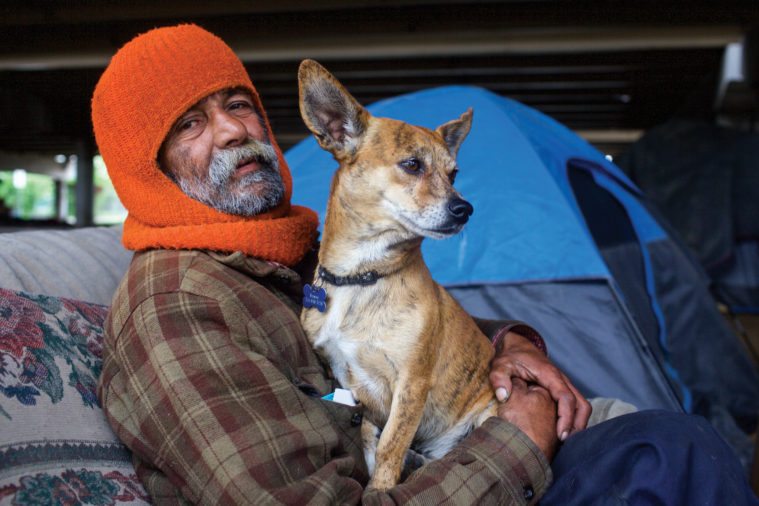
A few days after the mayor made his move-out threat, I decided to take the measure of Tent City’s dangers and witness the ugly eviction that was drawing near. I took a bus that dropped me a block away, then walked the length of Tent City, end to end. Strips of grass, about 10 yards wide, lay on both sides of I-45’s overpasses, which narrowed overhead as they split into exits leading to downtown. When vehicles entered or dogs ran about, they kicked up gritty clouds. What were once brightly colored nylon tents, most of them donated by the Christian groups, were streaked and smeared in shades of tan and gray.
Some people had placed their tents in clusters of circular or half-moon pods, five or six tents at each site, with their flaps turned inward, toward a center point. Others put them in lines, one or two tents in depth, their flaps facing in the same direction. The clusters, many fenced with shopping carts or bicycles, served to warn strangers to keep their distance, whereas the lines invited passersby to stop and chat.
As I was wandering about, a thin African-American woman in tattered tight pants approached me to say hello. I told her I wanted to move into the place but needed a tent. She led me into an adjoining block, where she announced herself at the pod of a man we’ll call Matt. Only seconds later, a younger man, apparently a lackey or assistant of some kind, came out of the cluster to stand at Matt’s shoulder, keeping an eye on me.
Matt was tall, dark and trim. His black T-shirt and jeans were dustless, even his shoes were clean, and he spoke in a measured basso voice that added dignity to his words. I thought maybe he was the head honcho, an ersatz mayor for his block. He was businesslike, “professional,” one might say. I didn’t know that whenever Matt spoke, he had a quick buck in mind.
He pointed me to a two-man tent with a couple of gashes in its fabric. For $10, it was mine. I told him I’d be back to get it the next day.
I had noticed vehicles parked next to about a dozen of the tents, and that had given me an idea: I’d bring my car, a 1974 Volkswagen Beetle, and my dog, Valjean, a Chow mix. I knew that both would draw the curious, making interviewing easier. Not being ready to occupy the tent the next day, I called at Matt’s abode to explain.
“Well, if you’re not going to take it ’til tomorrow, I gotta tell you, man, things do get stolen around here,” he said. “Why don’t you buy me a beer, $2? Just $2, man.”
I took that as a threat, that if I didn’t oblige, my tent would disappear. So I reached into my billfold and pulled out two bills. But I hadn’t arranged my bills in order, and I withdrew a one and a five. Matt had his fingers on my money before I could retract.
“Hey, that’s all right, man, I need that five,” he said. “I’ll pay you when you come back tomorrow.” I was pretty sure I’d never see that $5 again.
A couple of times during the week that followed, Matt offered me ways to redeem myself for being his creditor. I could go to a mall, buy five cellphones on credit and then, he said, he’d resell them and we’d split the proceeds. Either that, or he’d connect me with a woman who would take me, along with several others, to a clinic where we’d be given prescriptions for “hydro” — hydrocodone, an opiate. The lady would keep the pills herself and pay us $50 each, he said.
Matt, it turned out, was not only a merchant of tents, but a recruiter for the rackets as well.
I had planned to introduce myself at the camp as a reporter looking for a story. I’d even ordered business cards that said “Dick J. Reavis, aka ‘Pops,’ Journalist.” But my instincts — the result of reporting on wayward people in years past — told me not to identify myself to him. People like Matt don’t usually talk to reporters, and when they do, what they share isn’t always reliable. Police officers and social workers said gangs had infiltrated Tent City; indeed, one of the murders had been attributed to a drug deal gone bad. I decided that if I told Tent City’s residents I was an outsider, some might suspect I was an informant for the police. And if one person knew I was a reporter, I believed, soon the whole encampment would know.
I wanted my own look at life in the camp, not a few quotes based upon what sources volunteered to disclose. So I shelved my business cards, still in the box from the printer.
Dangerous as it may have been, Tent City was an attempt by the homeless to solve their problems themselves, in the only way they’d found.
Most of the line tents had what can only be called front porches. Every morning or afternoon their inhabitants swept the loose dirt around their tents into tiny dike-like piles that marked what in effect were property lines. Almost all of them placed inverted 5-gallon plastic buckets, discarded at restaurants or construction sites, at the sides of their flaps for use as seats. Some kept folding chairs in their tents as well, along with basic tools.
If Tent City had a paramount virtue, it was the camaraderie of front-porch chats, a bygone pastime elsewhere. In visits that began at midmorning every day, its residents joked, bragged and gossiped about recent events in their neighborhood. But they rarely mentioned their pasts. After all, they had begun new lives when they took to the streets.
Soldiers in the two world wars of the 20th century named their trenches after cities — “Los Angeles,” “Baltimore,” etc. — and American volunteers in the Spanish Civil War gave them New York City borough names. But the residents of Tent City hadn’t named their blocks. It was the authorities who did that, by assigning a letter to each block, A through E. The northernmost block, A, was where the druggies lived. Residents of other blocks said the place was trouble and that they stayed away, wary especially of people who used the drug K2. Those who lived on Block A were younger than elsewhere, and their eyes were trained on me when I walked by.
Sections B and C were predominately African American. Until the move-outs began, I never saw a white person quartered there. Quite by chance, I’d bought my tent, and had placed it, in Block D. That was a stroke of luck. A and D were probably the most racially integrated neighborhoods in all of Dallas, and besides that, D was the most densely populated sector of Tent City. One morning, a social work team counted 215 tents, and by my calculations, more than 60 of them were in Block D. By contrast, fewer than a dozen stood in E.
Daily life was a matter of routines, as anywhere. A comparison of daytime and night counts showed that about a quarter of the population left Tent City early in the mornings. Some headed for The Bridge, or for churches or 12-step centers that offer daytime refuge, coffee and breakfast. Some went panhandling. Others went to attend to bureaucratic hassles that arose from their requests for housing, medical care, food, cellphone or transportation subsidies. A few went to appointments or answered calls for odd jobs.
Those who remained in Tent City fell into another routine, at least on Block D. Between 9 and 10 a.m. they traipsed to a liquor store three blocks away. By noon, they were flying. By 3 p.m., when those who’d left Tent City in the morning began to trickle home, the babble and shouts of drunks were more than I could take. That’s usually when I went home.
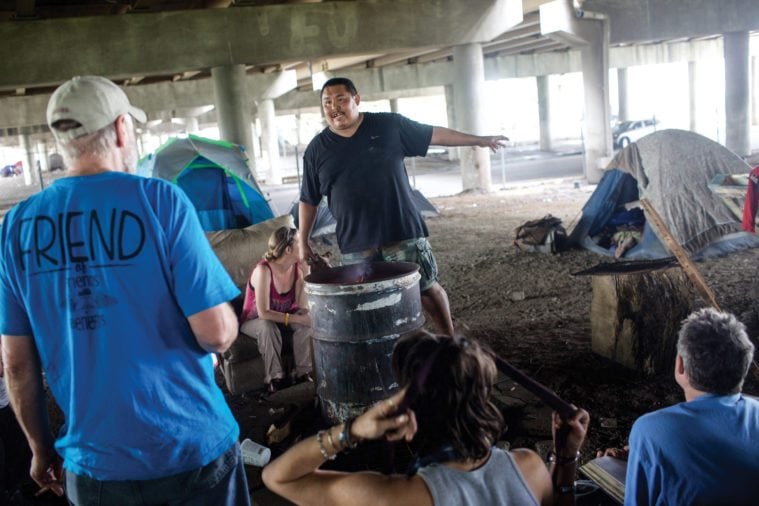
Two tents south of me lived a man called Luke, a cheerful, teetotalling African immigrant who slipped references to God into almost every conversation. In the mornings he’d usually disappear, to go downtown, he said. He’d come back about sundown, and with a moist cloth he’d wipe the dust off his tent and sponge off his shoes.
One afternoon, I found Luke cleaning a two-man tent adjacent to his, and thinking I might hire him for a dollar to do the same for mine, I approached to ask how much he charged.
“Oh, no, this is my tent, too,” he said. “I am a king. This one is my guest house!”
A few afternoons later, I found him hand-washing some clothes in two of the ubiquitous plastic buckets, one filled with soapy water, the other for rinsing. “Where did you get that much water?” I asked him. “Oh, when the truck comes to empty the toilets,” he said, “it comes with a water truck for refilling them. I get them to fill my buckets, too.
“Cleanliness is next to godliness,” he added.
Then there was Paul, a graying, muscular white guy of 61, waiting for his Social Security early-retirement age. He hailed from a nearby East Texas town and something about him told me that he’d been raised on a farm. He’d once had a job at a shelter operated by a church group, and that indicated he’d made a serious effort to quit drinking. His alcohol consumption in Tent City was moderate. Every morning he disappeared for several hours, saying that he was going to a church-affiliated center nearby “to charge my cellphone.” I suspect that he was still attending 12-step meetings. One morning, during a front-porch conversation with me and another neighbor, he bid us adieu by saying, “I’m looking forward to a sober day.”
About 10 yards from me lived a slightly built, balding man with a narrow, reddish face and a few missing teeth. I’ll call him Pete.
His story was that he’d been building a cellphone tower some three or four years earlier with a steel beam cradled in his arms, and he took a fall that shattered several vertebrae. He complained that one of his legs was 2 inches shorter as a result, and that he had chronic pain in his upper back. To keep his miseries at bay he spent his days as many people did, with a 40-ounce bottle of beer at hand.
A little to the north and east of Pete sat a three-person tent in which a middle-aged African-American couple, Henry and Celeste, had made their home. Their “porch” featured a vinyl-covered couch.
Between them and me lived Mark, a blue-eyed, graying, glib and seemingly fit white man in his early 50s who told me that before he moved to the streets three years ago, he’d been an ag-machinery mechanic. He was a back-slapping, cheerful sort who knew everybody and everything. His two-person tent was equipped with a mattress. At the front door, a half-sheet of plywood was mounted atop crates as a visitors’ bench, next to a gold Schwinn bicycle. Mark was so tidy that he always removed his shoes before entering his tent.
He claimed he’d arranged for a subsidized apartment by plying computers at a library, and that before the move-out came, he would abandon his tent for the new digs.
A frequent visitor to our line was a man of around 40, a long-haired redneck hippie I’ll call John. From one of the small towns in the region, he had been on the streets for three or four years. One Saturday afternoon, he entertained us with a grand tale about what he would do after the looming eviction. He owned a vintage 10-speed, lightweight bicycle with a matching trailer, and said he was going to ride to Seattle at a pace of about 60 miles a day.
“I’ll spend the summer because I’ve got friends there,” he said, “and when winter comes, I’ll get me a job on a fishing boat.”
“Most of those boats spend the winters in Alaska and the work is tough,” I warned him.
“I don’t care,” he said. “I’m a Texan. I can take it. In one winter I can earn enough to carry me for two years.”
The evacuation of blocks A and B the following week was memorable for its scenes of people rolling up sleeping bags under the watch of officers, women pushing belongings in shopping carts, men bent beneath mattresses on their backs.
No sooner had I sat down at Mark’s tent than Henry showed up, loud, drunk and profane. He stood, leaning toward Mark, shaking his finger and nearly spitting from his mouth. While Henry had been out somewhere that morning, Mark had given a bottle of beer to Henry’s wife, Celeste, and Henry thought Mark made the gift in an attempt to seduce her. “I’m telling you for the last time, don’t fuck with my wife!” he shouted. “I know you want to fuck her, but she don’t want nothing to do with you. I’m telling you — leave her alone!”
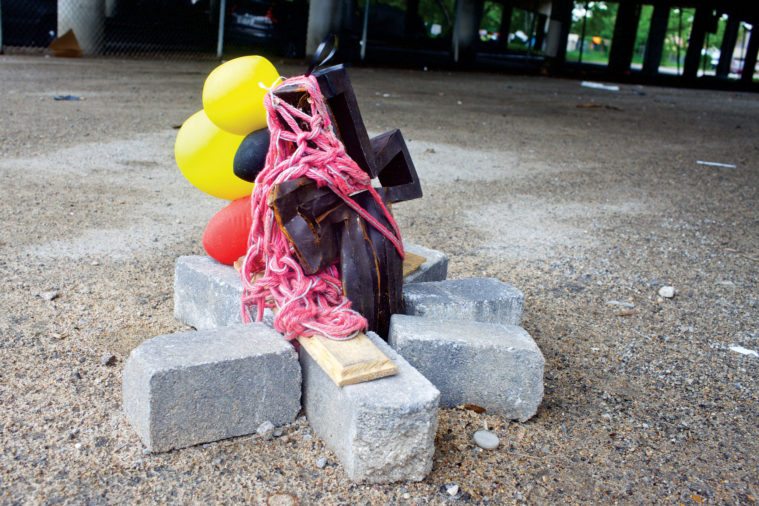
At every stanza of Henry’s tirade, which must have lasted about three minutes, Mark, in a low and calm voice, muttered a defense, saying that out of friendship he’d given Celeste “a drink.” Finally, Henry wheeled and stomped back to his tent, and Mark, in an almost teacher-like way, explained to me what had happened.
“Henry is always going off like that, but he’s all bark and no bite,” he said. “The son of a bitch thinks he can intimidate me, just by hollering. But I know how to handle guys like that.”
Then, taking a bottle of iced tea from my hand, he sat it on his end of the bench and began explaining a strategy.
“You see,” he said, pointing at the tea bottle, “these guys, they push on you. It’s like they’d pushed this bottle right back to where I am. I let them push until they get just so far. Then I start pushing back.” He inched my bottle toward me. “And little by little, I keep pushing back, until…” He nudged the bottle to the end of the bench. I reached over to stop its fall.
“You see, I push until they come to a point where they’ve got to do something,” he said. “Usually, 95 percent of the time, they’re like Henry. They just go away. Of course, 5 percent of the time they beat the shit out of me, but I’ve been through that before.”
A few minutes later, John and Pete walked over to Mark’s tent and posted themselves at its flap. Two African-American men who were passing by had meanwhile sat down with me on the bumper of my VW. They wanted to make friends with Valjean. We could see that behind his back, Pete was holding a steel camping hatchet. Shortly, we heard him cursing at Mark. Pete said that early in the day he’d left a bottle just outside his tent. He and John had decided that Mark had taken it and given it to Celeste. Mark denied anything of the kind, and the dispute continued.
The two visitors and I kept our eyes trained on the trio because Pete still had the hatchet behind his back. He then handed it to John and left. Soon, John was shouting, “Get out! Get the hell out of here! Right now! I mean it!”
Soon, a walking chase was underway. Mark tried to distance himself, but John kept following him. At points where John caught up, he punched Mark a time or two. Then he went back to Mark’s tent and dragged the gold Schwinn to the street, letting it drop on the curb. As Mark returned, he approached John and said, “For God’s sake, let me get my backpack before you throw it away.” Strangely, John stopped in his tracks and let Mark proceed.
Mark carried his backpack to the grassy area, pulled out a cellphone and raised it to his ear. “Go ahead, call the cops!” John hollered. “That’s what I’m doing,” Mark said.
Tent City lay about three blocks from a district police headquarters, and all day and night, cop cars whizzed along the street. Indeed, two had passed during the walking chase, but the officers hadn’t looked or seen anything. Now they came in a flash, entering on the south end of the block, trailing dust as they moved north. John, drunk as he was, knew what “assault with a deadly weapon” means and tossed his hatchet into the dirt several yards away. But by then the cop cars were drawing close. The police spread John against one of their vehicles, and when a cop found the hatchet, they put him in cuffs.
Someone had told me I could locate my tent anywhere a spot was open because “around here, it’s every man for himself,” a statement far more pregnant than I imagined at the time.
Friday morning, John was back. The police had only put him in a drunk tank. When I asked Mark what he thought, he said, “Well, I didn’t want to press charges. Why should I? John is my best friend.”
After I had spent weeks in Tent City, its casual violence no longer startled me. Nor was it surprising when men who’d been fighting one minute returned to being fast friends the next. The demons that afflicted so many of the people in Tent City were always near at hand, threatening to disturb the fragile peace that held among its denizens.
Mark’s acquiescence to assault, like the indifference of the police, was the rule in Tent City, not the exception. From January 1 to May 1, police records show 58 calls to Block B. One of them, in January, was designated “Major Dist (Violence),” but all of the others, including the call about the hatchet incident, were logged as “Routine Investigation.” The casual handling of assaults showed that the police, like social work agencies, were resigned to violence, as long as it did not make headlines. When it did, their response was not to implement measures to discourage, control or interrupt outbursts, but to evict, moving the problem elsewhere.
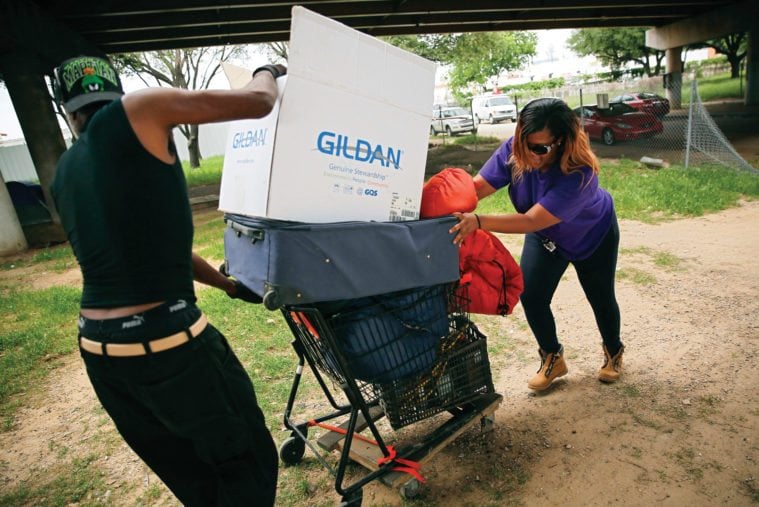
In early April, the city adopted a plan for the eviction of Tent City, block by block, over a period of weeks. Drawn by the MDHA from a model by a Canadian homelessness guru, it also called for the arrest of residents who refused to vacate. Nobody was sure where the displaced would go.
The social service agencies, old intimates of the intractability of the problems of the chronically homeless, endorsed the idea of a move-out, but expressed misgivings about setting a deadline, especially because the housing market is so tight. Shelter operators asked the City Council for a half-million dollars to expand their capacities, but the council didn’t even consider their proposal. Yet it came up with a $3 million subsidy to locate a Costco store in North Dallas, and Dallas County is eyeing $138 million for the restoration of JFK landmarks. It’s an old story: Expenditures to promote tourism and “economic development” win favor, while proposals to alleviate misery are dismissed.
The prevailing school of thought about chronic homelessness is called Housing First. Its central innovation is providing homes to the homeless, without drug tests, alcohol bans, or requiring beneficiaries to enroll in rehabilitation or job-search programs. Dallas has tried this on a limited scale and soon will open a 50-unit project under the concept. It is a departure — and at $136,000 per unit, an expensive one — that will stand in contrast to the city’s time-honored policy for the chronically homeless: Concentrate those with the most serious addictions, mental health afflictions, criminal records and countless unnamed traumas — and then look away for a while. Dallas isn’t willing to try a full-fledged Housing First approach, nor is it willing to provide a measure of security in encampments such as Tent City.
After two postponements, the move-out of thinly populated block E was accomplished on the morning of April 19. When the police showed up, nobody was there. Those who intended to stay in Tent City simply moved into Block D.
The evacuation of blocks A and B the following week was memorable for its scenes of people rolling up sleeping bags under the watch of officers, women pushing belongings in shopping carts, men bent beneath mattresses on their backs. MDHA CEO Cindy Crain was on hand, using her SUV to help residents transport their possessions. As many as half of the refugees left Tent City for parts unknown, but the others just crowded into the blocks that weren’t slated for clearing yet. Officials in black shirts bearing the words “Crisis Intervention Team” supervised their exodus, and men with vests labeled “Hazmat” began cleaning operations once everybody was gone. A few of the displaced whimpered or shed tears, but nobody refused to go.
Tent City’s final week, when only blocks C and D remained, was unpleasant for everyone. A stabbing had occurred in Block A just days before it was evacuated, and rumors circulated of another on Block C.
On Friday, April 27, I watched an old lady assault a younger woman as the pair crossed the street between C and D. Both were residents of D and well-known to my neighbors, who were watching with me. Two bystanders joined in the fray, which did not end until seven police cars and two ambulances came. The police accompanied the elder woman to her tent and led the younger woman away to a shelter.
On Block D, I had a couple of times chatted with a lady in her 50s who was usually accompanied by a 5-month-old Chihuahua that sometimes snapped and played with laid-back Valjean. Like many Tent City residents, she didn’t keep her dog on a leash. On the southern end of the block lived a man who had two dogs, usually unleashed, a friendly German Shepherd and a quarrelsome bitch of untraceable lineage. That weekend, the Chihuahua wandered into the mutt’s territory and the mutt killed it with a bite to the spine.
“For the Dallas civic mind, human frailty is not their thing. They think you can see everything from a skybox, and so they don’t take the ground view.”
But for most of the people on Block D, eviction wasn’t a specter dire enough to inspire any vows. Until its eve, people said they’d deal with the move-out when it came, as if leaving wasn’t certain or a big deal. Paul, who had moved to Tent City from an encampment near Fair Park at the urging of the police, said, “Well, they always move us around, but usually that happens at State Fair time.”
Pete told me that he, too, had been evicted before, in North Carolina. “You see,” he said, “the thing is, we don’t pay any property taxes. It’s the money.” He said his North Carolina relocation had come about because “we were on private property, you see. The owner wanted to build a development there. So they found another place for us, and we moved.” A street preacher who frequented the camp tried to find volunteers to join him in passive resistance to the eviction, but he found no takers.
By Sunday afternoon, a few Block D residents were ready to leave. “It’s about time they break this place up,” a neighbor said. “There’s a little too much action around here.” Nobody was really fond of Tent City; they’d have rather been indoors. The toilets and dumpsters at Tent City were convenient, but almost everyone on Block D had lived without them before. More important, they knew that wherever they were, the church group’s food trucks would find them.
Pickups belonging to relatives and the church groups came to take a couple of people away, but everybody else stayed put, business as usual. Andy, who had sobered, didn’t move anywhere. When nightfall came, some of the more hardened types, including Matt and his cronies, simply vanished, leaving their tents behind. Pete toted his belongings to an encampment about a mile away.
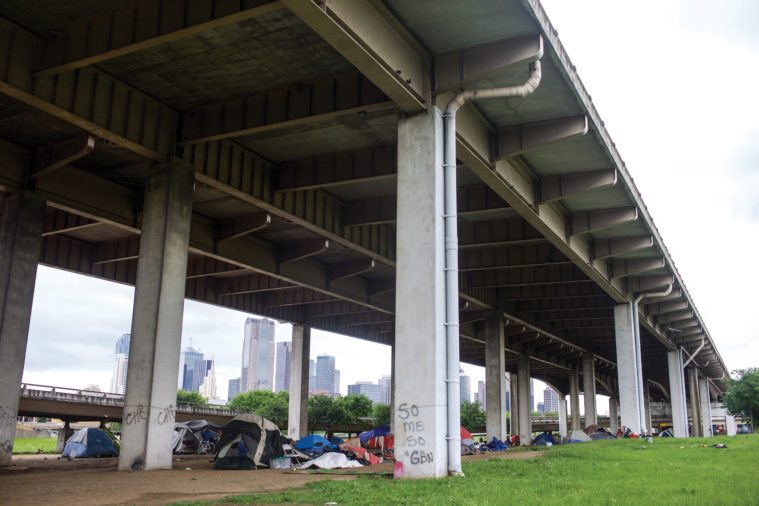
The move-out came Tuesday, May 3, right on time at 8 a.m. The refugee scenes of the previous evictions were repeated, but policemen didn’t roust anybody. Social workers handled the whole show, even handing out plastic trash bags. I counted 32 of the bags, standing full, in front of Luke’s tent. Staffers from the MDHA dispatched some residents, mostly women, to apartments, motels and shelters.
A count by the MDHA showed that when the move-out began, Tent City’s population had declined to 204. By the time it was finished, housing had been found for 53 of its residents. Another 32 had entered shelters. But 88 of Tent City’s former residents merely shifted to two smaller encampments, one about half a mile away under I-30, another a few blocks away, beneath I-45.
I looked for some of my Tent City friends for a couple of weeks following their diaspora. Several of the women, including the Chihuahua lady, were still in motel or shelter lodgings. Mark checked into a shelter pending an inspection of his much-vaunted apartment, or so he said. Luke had moved into a fleabag motel; for how long, only he can say. But most of the others, including Paul, were at the nearby encampments. On May 26, there was a shooting at one of the nearby encampments, said to be related to a K2 sale.
A new MDHA survey showed the populations of the two burgeoning encampments as 63 and 79, about the same as blocks C and D had been. The city’s response to the growing camps was to announce the formation of a new commission to draw proposals for housing the homeless; the current plan was supposed to have been implemented by 2014.
Old hands were unimpressed with the whole affair. One of them was John Fullinwider, a 64-year-old graybeard who spent a decade as a housing activist, but is now better-known for protesting police brutality and Confederate monuments. Fullinwider served on the first Mayor’s Special Committee on the Homeless. It culminated in a thorough plan for easing the problem — back in 1985 — but its full implementation was delayed for more than 20 years. After his stint with officialdom, Fullinwider became an aide to Prince Johnson, a homeless man who in 1993 and ’94 sparked protests against the city’s anti-homeless ordinances and the bulldozing of an encampment called Shantytown. But in the years since, Fullinwider has been disheartened.
“For the Dallas civic mind,” he says, “human frailty is not their thing. They think you can see everything from a skybox, and so they don’t take the ground view. What’s important to them is the big picture, where they figure out how they’re going to manipulate everything and come up with a ‘world-class’ view.”
The April and May evictions moved some people from Tent City, the urban core of the homeless, into its villages, and even dispersed a few to rural settlements in the wooded crannies of Dallas. As in small towns, their social networks and opportunities for hostile encounters have been reduced in their new locales. Despite the shooting that followed Tent City’s closure, a few conflicts that would have been settled by firearms, fists and blades have probably been avoided. But the only plan underway for the two growing freeway camps where Tent City’s people fled calls for their evacuation too. The first of them was emptied on July 19.
The names of homeless people mentioned in this story have been changed to protect their privacy.
